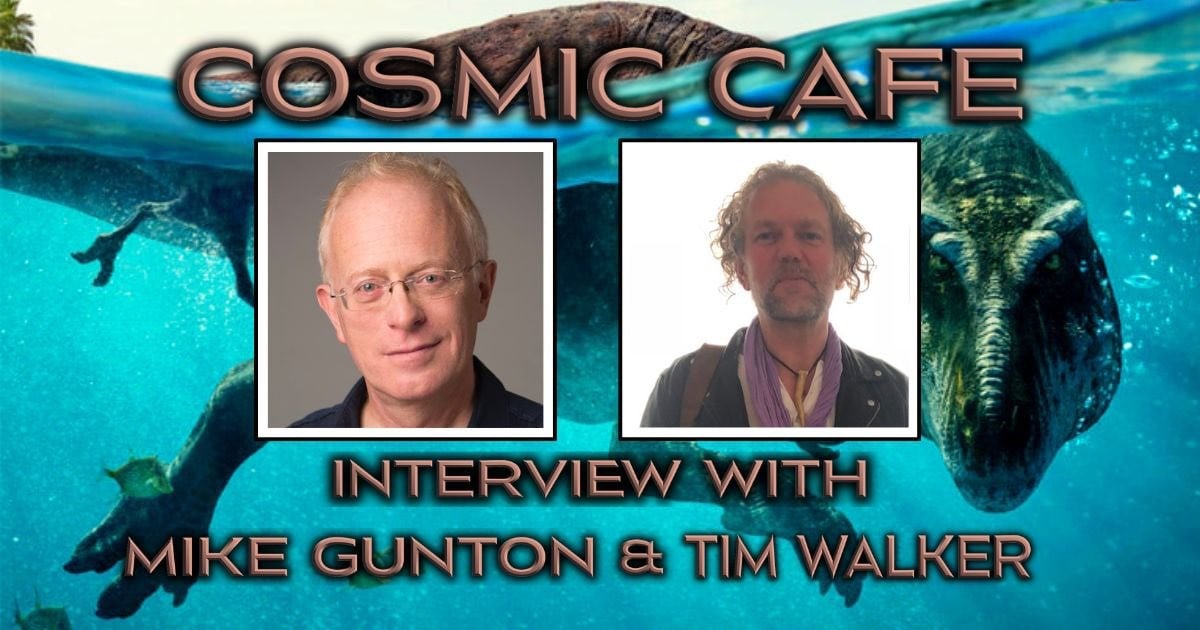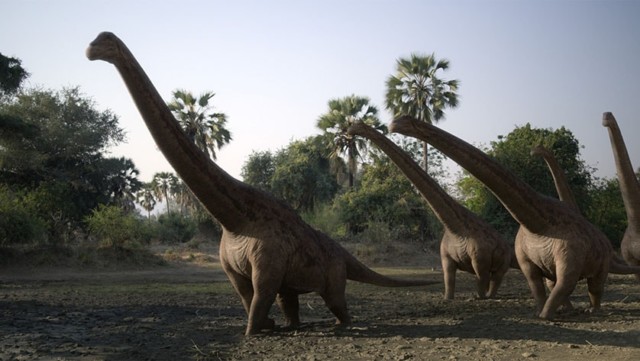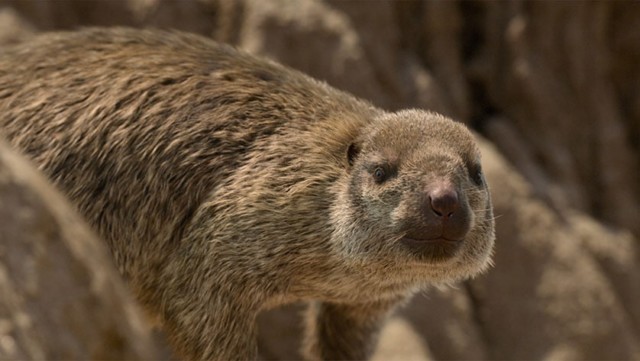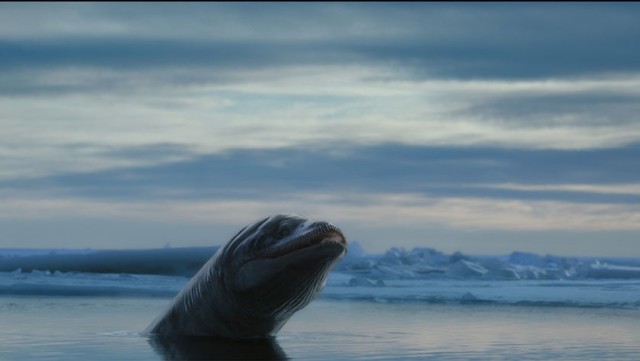Cosmic Cafe: Interview with Prehistoric Planet’s Mike Gunton and Tim Walker

Prehistoric Planet is a documentary series on Apple TV+ that combines state-of-the-art realistic animation with stunning cinematography to transport viewers back to the Cretaceous period, 66 million years ago. The series features never-before-seen “footage” of dinosaurs and other prehistoric creatures in their natural habitats. Sir David Attenborough, the legend of documentary series like Planet Earth, even narrates it. Executive Produced by John Favreau, Prehistoric Planet uses tech from hit shows like The Book of Boba Fett to bring these animals to life.
On Tuesday, The Cosmic Circus had the opportunity to sit down over Zoom with the show’s executive producer Mike Gunton and showrunner Tim Walker. Both are highly accomplished filmmakers in the world of natural history. Gunton is known for his work on the Emmy and BAFTA-winning Planet Earth II, as well as Galapagos, Yellowstone, Madagascar, and Life. Walker has a similarly impressive career, with 20 years of bringing natural history to the screen.
There are five episodes in the new season, each tied to a different habitat and the animals that lived there. In our interview, we chatted about dinosaurs (of course!) but also how they built on the technology from season 1, creating empathy for these prehistoric characters and more. Listen to the full interview below or on most apps where podcasts are available.
Timestamps:
-
- 00:00 – Intro
- 00:45 – executive producer Mike Gunton and showrunner Tim Walker tell us a little bit about themselves and what they do for the series
- 02:10 – Mammals and other new creatures in Prehistoric Planet season 2
- 03:30 – Favorite episode or moment in season 2
- 06:30 – Talk about the CGI animation in the series and creating empathy for computer-generated creatures
- 07:33 – Pushing the boundaries of new technology and bringing in night vision and heat vision into the series
- 09:30 – What Gunton and Walker want people to take away from the series. Are there plans for a Prehistoric Planet season 3?
- 10:44 – Outros

[Interview highlights below. Please note: These responses have been lightly edited for clarity.]
Dinosaurs, mammals, and more in the second season of Prehistoric Planet
Prehistoric Planet was splashy in part because of the groundbreaking CGI and animation used to bring the dinosaurs to life. The second season uses some of that magic to round out the picture of the Earth from so long ago. We get to see mammals – something not always mentioned in the same breath as dinosaurs.
Ayla Ruby: “I was amazed by it, even just in the first episode. The mammal, I’m going to mess this name up horribly, the adalatherium. I felt so much for her, and I think you guys have done such a great job. Actually, I wanted to talk about her, too. You’ve got other animals besides just dinosaurs in this season, right? There’s more animals from the ecosystem. Can you talk about that, because I think that’s different than the first season?”
Tim Walker: “It is, yeah. One of the things we’re very keen to bring to this new season was new dinosaurs, new habitats, and new characters. We’ve introduced about 25 new characters into this new season since the first one. About 15 of them are dinosaurs, but we’ve then expanded the universe, so to speak. We’re painting a picture of the prehistoric planet as being very diverse, very rich, and so we’ve brought the mammals in.”

Tim Walker: “Who knew mammals were around at the same time as dinosaurs? We did, but I think lots of the general public don’t realize this. They thought dinosaurs got wiped out, and then the mammals came along. Mammals have been around for ages, almost about the same time as dinosaurs, but they were generally small. It’s only in the latter stages, they started to get big. Then we bring fish in for storylines, and birds, and other reptiles. It’s just all part of painting this very rich world, which is building on what we saw in season one.”
Evolving filmmaking techniques
It’s been a journey to bring Prehistoric Planet season 2 to the screen, and filmmaking technology has evolved. Just since the first season premiered, there have been advances that would help make the storytelling richer – paralleling the evolution of the animals profiled. The second used 1183 VFX shots and was filmed in locations from Australia and Iceland to Georgia and North Carolina in the United States. We talked with Gunton and Walker about using those new techniques this season.
Ayla Ruby: “It seemed like there was a lot different, as well, with the technical parts of the filmmaking. There was night vision, I think. There was heat vision; maybe I’m conflating this.”
Mike Gunton: “Yeah, that’s right.”
Tim Walker: “Yeah.”
Ayla Ruby: “Can you talk about the decisions to bring those into play? Why that?”
Tim Walker: “Why? The thing is, with any sequel. When you people first saw Planet Earth, there was then an expectation that Planet Earth 2, the sequel, would push the boundaries of filmmaking and in terms of the behavior and what have you. We followed the same ethos. Season 1 laid the benchmark, and then we’ve pushed the boundaries to incorporate different filming techniques. We see thermal imaging; like you say, we see night vision. Some of the night vision cameras that we use today can make nighttime look like daytime, basically, and so we followed the same rationale there. We’ve introduced a lot more slow motion, so you can see fine detail in some of the action. And we’re taking the camera closer, literally closer, in terms of seeing a lot more closeups of the animals.”

Mike Gunton: “It is like art following science. It’s very weird. This whole process has been quite a bit of a mess with your head, really, because it is like art following life. Because, as Tim said, that’s exactly what would happen when we make a Planet Earth, new technology would appear, which we then push the boundaries with. That also happened in this because we were able to technically use that tech. We probably didn’t have the technical skills on series one to be able to recreate a thermal camera, or an ultra-high-speed camera, or a night vision camera. Weirdly, we’re both copying that sort of evolution we’ve seen in the real world, but actually, it is a true evolution, as well. So no wonder we’re all going to have to have a big holiday when this is whatever because our heads are all going to a point.”
Extraordinary animals, not monsters
Gunton and Walker’s passion for the prehistoric era was infectious, and we talked about what they wanted people to take away from the series after watching it. There’s an enduring quality to shows like Planet Earth, and Prehistoric Planet 2 also has that magic.
Ayla Ruby: “What do you want folks to take away from watching this mini-series event? What would be your ideal for them to walk away thinking and feeling after it? Also, are there plans for a third one?”
Mike Gunton: “I was just going to say I would love people to be as excited by the long-lost prehistoric world as we are. And I think people are. I think that everybody loves the prehistoric world when they’re a child, and it’s still there lurking in the background. We just need to pull it out of them.”
Tim Walker: “That these were extraordinary animals, not monsters. That world was utterly full of life and has huge parallels to the world we live in today. That is a thought-provoking thing to do, to think about, to stand and look back in time, but also look at ourselves, look at life today. We are a tiny blink of an eye in the history of our planet, and that’s quite a thought-provoking thing to do.”
How to watch Prehistoric Planet season 2
You can watch the Prehistoric Planet season 2 “Islands” premiere episode on Monday, May 22, on Apple TV+. New episodes will air daily until it concludes on Friday, with an episode titled “North America.” You don’t need to have watched season 1 before enjoying the late Mezozoic majesty of season 2, but if you’re a dinosaur geek, you’ll want to check it out ahead of time anyway.
Are you about the upcoming season of Prehistoric Planet? Are you rewatching season 1 to get ready? Did you have a favorite Cretaceous moment? Please join the conversation on Twitter or head to our Discord. And if you want more interviews, you can check out the rest of the Cosmic Cafe series here.
Cosmic Cafe: Interview with Bill Motz and Bob Roth from The Ghost and Molly McGee
Exclusive Interview: VFX Supervisor Erik Henry Talks Apple TV’s Invasion




